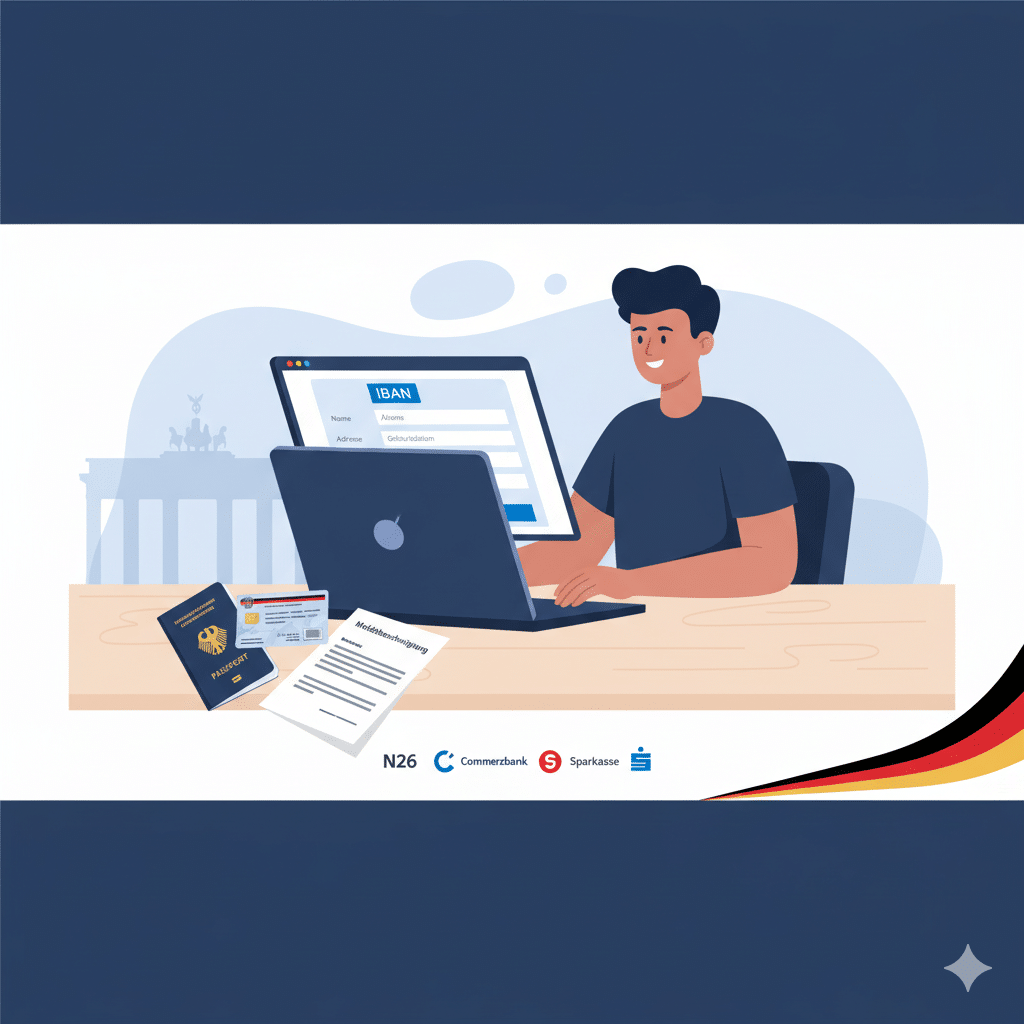Opening a bank account (Girokonto) is one of the first and most important steps when moving to or living in Germany. Whether you are an expat, a student, a freelancer, or a long-term resident, you’ll need a local account for rent payments, salary deposits, and everyday expenses. In this 2025 guide, we’ll walk you through the process of opening a German bank account — requirements, documents, best banks, and ID verification methods like PostIdent and VideoIdent.
Why You Need a German Bank Account
- Salary and rent: Employers and landlords typically only transfer money to a German IBAN (International Bank Account Number).
- Payments: Utility bills, insurance, and subscriptions are usually paid via SEPA direct debit from a local Girokonto.
- Financial credibility: A local account helps when applying for services like mobile contracts, loans, or even rental agreements.
Step-by-Step: How to Open a Bank Account in Germany (2025)
1. Choose Your Bank
You can open an account with:
- Traditional banks: Sparkasse, Commerzbank, Deutsche Bank
- Direct/online banks: DKB, ING, N26
- Fintechs: Revolut, Wise (great for international transfers)
👉 Tip: Expats often prefer N26, Wise, or DKB for easy English support, while locals may opt for Sparkasse or Commerzbank for in-branch service.
2. Gather the Required Documents
Typical documents include:
- Valid passport or Personalausweis
- Meldebescheinigung (registration certificate from your local Bürgeramt)
- Residence permit/visa (for non-EU nationals)
- Proof of income (sometimes for credit/debit cards)
📌 Note: Some fintech banks (e.g., N26, Wise) allow account opening without a Meldebescheinigung, but most traditional banks require it.
3. Complete the Application
- Online: Fill in your details via the bank’s website or app.
- In-branch: Visit a branch, provide documents, and fill out forms.
4. Verify Your Identity
Two common methods in Germany:
- PostIdent: Go to a Deutsche Post office with your documents; staff verify your identity.
- VideoIdent: A quick video call with your ID/passport; increasingly popular with online banks.
5. Receive Your IBAN & Banking Details
Once verified, you’ll receive:
- IBAN (German account number)
- Debit card (Girocard or Mastercard/Visa Debit)
- Online banking login details
6. Account Activation
- Online banks: Usually within 1–3 business days
- Traditional banks: Can take 3–7 business days
Can I Open a German Bank Account From Abroad?
Yes, but only with certain banks. Fintechs like N26 and Wise allow remote account opening with VideoIdent, often before you move to Germany. Traditional banks generally require a Meldebescheinigung, meaning you need to be registered locally.
Special Cases
For Non-EU Nationals
You’ll need a valid residence permit/visa plus your passport.
Some banks may request proof of income or enrollment (for students).
For Students
Many banks (like Deutsche Bank or DKB) offer free student accounts.
Requirements: proof of enrollment (Immatrikulationsbescheinigung).
For Freelancers & Self-Employed
Look for banks offering business accounts (Geschäftskonto) — N26 Business, Kontist, or Commerzbank Business.
Important: Keep personal and business accounts separate for tax purposes.
Best Banks for Expats in Germany (2025)
N26 – App-based, full English support, easy to set up abroad
Wise (ex-TransferWise) – Best for international transfers, low FX fees
Commerzbank – Free Girokonto if salary is paid in; wide ATM network
DKB – Popular online bank with free worldwide ATM withdrawals
Sparkasse – Local, reliable, with extensive branch network
Girokonto vs Tagesgeldkonto
Girokonto: Everyday checking account (salary, rent, payments)
Tagesgeldkonto: Savings account with variable interest rates; not for daily expenses
👉 Most people start with a Girokonto, and then add a Tagesgeldkonto for savings.
Costs: How Much Does a Bank Account Cost in Germany?
Online/fintech banks: Often free (N26, Wise, DKB)
Traditional banks: €5–10/month if you don’t meet minimum deposit requirements
ATM withdrawals: Free at your bank’s ATMs, fees may apply elsewhere
Common Questions (FAQs)
1. What documents do non-EU citizens need to open a bank account?
Passport, residence permit/visa, and Meldebescheinigung. Some online banks require fewer documents.
2. Can I open a German bank account remotely before moving?
Yes, with banks like N26 and Wise using VideoIdent. Traditional banks usually require local registration.
3. Which German bank is best for expats?
N26 and Wise for easy English support, DKB for strong online banking, and Commerzbank for in-branch service.
4. How long does account activation take?
1–3 days for fintech banks; up to a week for traditional banks.
5. What is the difference between Girokonto and Tagesgeldkonto?
Girokonto = daily transactions, Tagesgeldkonto = savings with interest.
Conclusion
Opening a bank account in Germany may seem bureaucratic, but once you understand the process, it’s straightforward. Start by choosing whether you prefer a digital-first bank like N26 or Wise, or a traditional bank like Commerzbank or Sparkasse. Have your documents ready, complete the ID check, and within a few days you’ll have your German IBAN ready to use.

